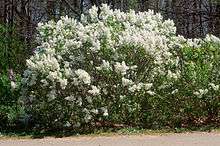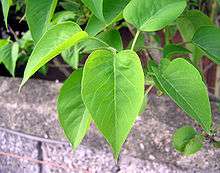| Lilacs | |
|---|---|
.jpg) | |
| Genus: | Syringa |
| Family: | Oleaceae |
| Type: | Shrubs and Trees |
| Pruning season: | After flowering |
| Weediness: | Can sucker aggressively |
| Pollination: | Insects |
Lilacs (Syringa) are a genus of about 20 species of flowering plants in the family Oleaceae (olive), native to Europe and Asia. The genus name Syringa is derived from syrinx meaning a hollow tube or pipe, and refers to the hollow state of the younger shoots in some species. The name "pipe tree" is occasionally used.
Description
Lilacs range in size from large shrubs to small trees, 2-10 m tall. The leaves are opposite (occasionally in whorls of three), deciduous, and in most species simple and heart-shaped, but pinnate in a few species (e.g. S. laciniata, S. pinnatifolia). The flowers are produced in spring, each flower about 1 cm diameter, white, pale pink or more generally purple, with four petals. The flowers grow in large panicles, and in several species have a strong fragrance. Flowering starts after 80-110 growing degree days.
Growing conditions
Species
Uses
Lilacs are popular shrubs in parks and gardens throughout the temperate zone. In addition to the species listed above, several hybrids and numerous cultivars have been developed. The term French lilac is often used to refer to modern double-flowered cultivars, thanks to the work of prolific breeder Victor Lemoine.
The wood of lilac is close-grained, diffuse-porous, extremely hard and one of the densest in Europe. The sapwood is typically cream-coloured and the heartwood has various shades of brown and purple. Lilac wood has traditionally been used for engraving, musical instruments, knife handles etc. When drying the wood has a tendency to be encurved as a twisted material, and to split into narrow sticks. The wood of Common Lilac is even harder than for example that of Syringa josikaea.
Purple lilacs symbolise first love and white lilacs youthful innocence.
Maintenance

Lilacs flower on old wood, and produce more flowers if unpruned. If pruned, the plant responds by producing fast-growing young vegetative growth with no flowers, in an attempt to restore the removed branches; a pruned lilac often produces few or no flowers for one to five or more years, before the new growth matures sufficiently to start flowering. Unpruned lilacs flower reliably every year. Despite this, a common fallacy holds that lilacs should be pruned regularly. If pruning is required, it should be done right after flowering is finished, before next year's flower buds are formed. Lilacs generally grow better in slightly alkaline soil.
Propagation
Harvesting
Pests and diseases
Crown Gall
- Agrobacterium tumeifaciens
Bacterial Blights
- Pseudomonas syringae
- Microsphaera alni (Some control can be provided by a snail (Polygyra thyroides))
- Cercospora lilacis
- Macrophoma halstedii
- Phyllosticta porteri
- Phyllosticta syringae
- Phyllosticta syringella
- Ploeospora herbarum
Leaf Blights
- Cladosporium herbarum
- Heterosporium syringae
White Mold
- Scletotinia
Diebacks
- Physalospora obtusa
- Verticillium albo-atrum
Shoot Blight
- Gloeosporium syringae
Thread Blight
- Pellicularia koleroga
Stem Girdles
- Hymenochaete agglutinans
Wood Rots
- Polyporus versicolor (vectored by the lilac borer)
Mushroom Rots
- Armillaria
- Phytophthora cactorum
- Phytophthora syringae
Viri
- Ringspot
- Leafroll
Phytoplasma
- Witches’ Broom (LWB)
- Root Knot
Climate-related Issues
- Frost injury (causes flower bud failure)
- Pollution injury (causes leafroll)
- Susceptible to graft incompatibilities
- Melon Aphid: Aphis gossypii
Scales
- Scurfy Scale: Chionaspis furfura
- Oystershell Scale: Lepidosaphes ulmi
- Olive Parlatoria Scale: Parlatoria pittospori
- White Peach Scale: Pseudaulacapsis pentagona
- Cottony Maple Scale: Pulvinaria innumerabilis
- San Jose Scale: Quadraspidiotus perniciosus
- Euonymus Scale: Unaspis euonymi
- Prunicola Scale: Pseudaulacaspis prunicola
- Citrus Whitefly: Dialeurodes citri
- Ash Whitefly: Siphonius phillyreae
- Privet Thrips: Dendrothrips ornatus
- Japanese Beetle: Popillia japonica
- Rhinocerus Beetle: Xylorcetes jamaicensis
- Twobanded Japanese Weevil: Callirhopalus bifasciatus
- Ligustrum Weevil: Ochyroma ligustri
- Black Vine Weevil: Otiorhynchus sulcatus
- Polyphemus Caterpillar: Antheraea polyphemus
- Promethia Moth: Callosamia promethia
- Obliquebanded Leafroller: Choristoneura rosaceana
- Hickory Horned Devil Caterpillar: Citheronia regalis
- Lilac Leafminer: Gracillaria syringella
- Cercopia Moth: Hyalophora cercopia
- Fall Webworm: Hyphantria cunea
- Lilac Borer: Podosesia syringae syringae
- Cynthia Moth Caterpillar: Samia cynthia
- Leopard Moth Borer: Zeuzera pyrina
- Great Ash Sphinx: Sphinx chersis
- Hummingbird Clearwing: Hemaris thysbe
- w:Copper Underwing
- w:Scalloped Oak
- w:Svensson's Copper Underwing
- Giant Hornet: Vespa crabro germana
Bees
- Leafcutter Bees
- Lilac Rust Mite: Aculops massalongoi
Gallery
 Lilac leaves
Lilac leaves Lilac flowers
Lilac flowers Lilac flower head of a double-flowered cultivar
Lilac flower head of a double-flowered cultivar
References
- Flora Europaea: Syringa
- Flora of China: Syringa
- Flora of Pakistan: Syringa
- Christopher Brickell and Judith D. Zuk (1997). The American Horticultural Society A-Z Encyclopedia of Garden Plants. DK Publishing. pp. 993-995.
- Staff of the L. H. Bailey Hortorium (1976). Hortus Third: A Concise Dictionary of Plants Cultivated in the United States and Canada. Cornell University Press. pp. 1090-1091.
- Pirone, Pascal P. (1978). Diseases & Pests of Ornamental Plants (Fifth Edition ed.). John Wiley & Sons, New York. pp. 492-497.
- Cranshaw, Whitney (2004). Garden Insects of North America: The Ultimate Guide to Backyard Bugs. Princeton University Press. pp. 622.
- Pippa Greenwood, Andrew Halstead, A.R. Chase, Daniel Gilrein (2000). American Horticultural Society Pests & Diseases: The Complete Guide to Preventing, Identifying, and Treating Plant Problems (First Edition ed.). Dorling Kindersley (DK) Publishing, inc.. pp. 196.